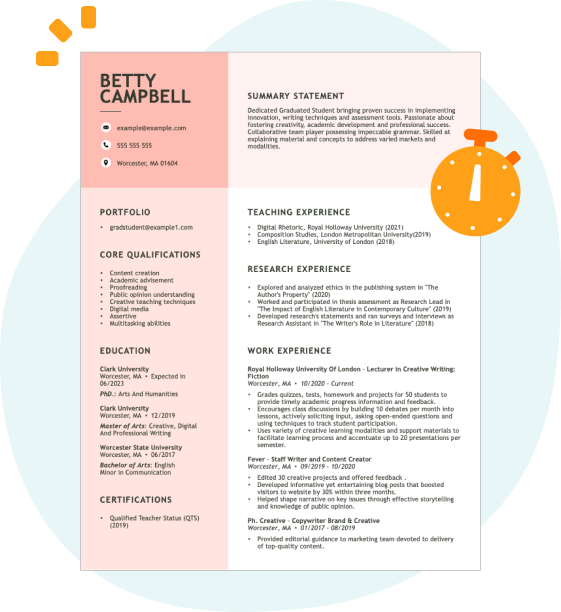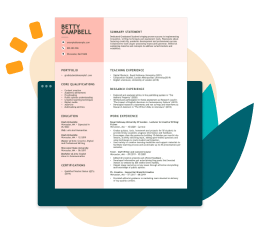Hard skills include skill in operating various machining tools, understanding technical drawings, and performing precise measurements essential for producing high-quality components.
Popular Machinist Resume Examples
Check out our top machinist resume examples that emphasize skills such as precision machining, blueprint reading, and problem-solving abilities. These examples will guide you in showcasing your expertise effectively to potential employers.
Looking to build your own resume? Our Resume Builder offers user-friendly templates specifically designed for machinists, making it simple to create a professional document that highlights your strengths.
Entry-level machinist resume
This entry-level resume highlights the applicant's skill in CNC operations and notable achievements, including a 20% improvement in production efficiency. New professionals should demonstrate their technical skills and commitment to safety and quality through quantifiable accomplishments, even with limited work experience.
Mid-career machinist resume
This resume effectively showcases essential qualifications by detailing hands-on experience and leadership in training junior machinists. The clear articulation of skills and accomplishments highlights the job seeker's readiness for advanced responsibilities and complex challenges in machining.
Experienced machinist resume
This resume's work history section illustrates the applicant's extensive experience as a machinist, highlighting their impressive achievements like reducing setup time by 30% and cutting incidents by 50%. The bullet-point format improves readability, making it easy for hiring managers to quickly assess qualifications.
Resume Template—Easy to Copy & Paste
Yuki Sato
Parkview, MO 64152
(555)555-5555
Yuki.Sato@example.com
Professional Summary
Experienced Machinist with expertise in CNC programming, precision measurement, and process optimization. Proven track record of increasing output efficiency by 15% and reducing defects. Committed to enhancing productivity in manufacturing environments.
Work History
Machinist
Precision Tool Works - Parkview, MO
January 2023 - December 2025
- Increased output by 15% via process improvements.
- Reduced defect rate by 10% using quality checks.
- Assembled components with precision and skill.
CNC Operator
Advanced Machining Co. - Parkview, MO
January 2021 - December 2022
- Operated CNC machines to achieve high efficiency.
- Enhanced accuracy by 20% applying calibration.
- Executed complex setups with excellent results.
Manufacturing Technician
TechFabrication Ltd. - Parkview, MO
January 2020 - December 2020
- Managed inventory, optimizing turnaround times.
- Assisted in reducing scrap by 12% effectively.
- Conducted machine maintenance improving uptime.
Languages
- Spanish - Intermediate (B1)
- German - Beginner (A1)
- Chinese - Beginner (A1)
Skills
- CNC Programming
- Precision Measurement
- Blueprint Reading
- Machine Setup
- Quality Assurance
- Maintenance Repair
- Process Optimization
- Lean Manufacturing
Certifications
- Certified Machinist - National Institute for Metalworking Skills
- CNC Machine Operator Certification - Tooling U-SME
Education
Associate's Degree Manufacturing Technology
Midwest Technical Institute Springfield, Illinois
May 2019
High School Diploma General Education
Springfield High School Springfield, Illinois
June 2017
How to Write a Machinist Resume Summary
Your resume summary serves as the gateway to your job application, making an immediate impact on potential employers. It's important for machinists to craft a compelling introduction that showcases both technical skills and relevant experience.
In this role, highlight your skill with machinery, precision in operation, and any specialized certifications. These are key factors that hiring managers look for when considering applicants for machinist positions.
To better grasp what makes an effective resume summary for a machinist position, examine these examples. They will illustrate successful strategies and common pitfalls:
Weak resume summary
I am a machinist with many years of experience in the field. I am looking for a job that allows me to use my skills effectively and provides great benefits and growth opportunities. I believe I can be a valuable addition to any team.
- Uses broad statements like "many years of experience" without specific achievements or skills
- Emphasizes what the applicant seeks rather than what they can contribute, making it less appealing to employers
- Lacks strong action verbs and concrete examples, resulting in generic language that fails to stand out
Strong resume summary
Detail-oriented machinist with over 7 years of experience in precision manufacturing, specializing in CNC machining and tool calibration. Achieved a 20% reduction in production time by implementing lean manufacturing practices, while maintaining a defect rate below 1%. Proficient in using CAD software, interpreting blueprints, and operating various milling and lathe machines to produce high-quality components.
- Begins by clearly stating the job seeker's experience level and area of expertise
- Highlights a quantifiable achievement that showcases efficiency improvements and quality control
- Mentions specific technical skills that are important for machinist roles, demonstrating industry knowledge
PRO TIP
Showcasing Your Work Experience
The work experience section is important for your resume as a machinist, representing the bulk of your content. Good resume templates consistently include this essential section to effectively showcase your skills.
This area should be organized in reverse-chronological order, detailing your previous positions. Include three to four bullet points that highlight your key achievements and contributions in each role.
To help you understand what makes an effective work history section, we will present a couple of examples that illustrate best practices. These examples will clarify what works well and what doesn't:
Machinist
Precision Tools Inc. – Detroit, MI
- Operated machinery
- Maintained equipment and tools
- Followed safety protocols
- Worked with a team on projects
- No details about the employment dates
- Bullet points are vague and do not highlight specific skills or contributions
- Focuses on routine tasks rather than showcasing achievements or measurable outcomes
Machinist
Precision Engineering Co. – Chicago, IL
March 2020 - Current
- Operate CNC machines to produce precision parts, achieving a defect rate of less than 1% over three years
- Implement process improvements that increased production efficiency by 30%, contributing to on-time delivery metrics
- Train and mentor junior machinists, improving team competency and ensuring adherence to safety protocols
- Starts each bullet with effective action verbs that highlight the applicant's contributions
- Incorporates specific metrics demonstrating the job seeker's effectiveness in their role
- Showcases relevant skills and experiences that align with industry standards
While your resume summary and work experience are important components, don’t overlook the importance of other sections that contribute to your overall presentation. For detailed guidance on crafting a well-rounded resume, be sure to check out our comprehensive guide on how to write a resume.
Top Skills to Include on Your Resume
A skills section is an essential part of your resume because it gives employers a quick view of your qualifications. This section lets you highlight the specific abilities that make you a strong job seeker for the machinist role.
Employers seek professionals who blend technical expertise with strong communication and collaboration skills. Highlighting both hard and soft skills on your resume shows you can perform effectively and work well with others.
Soft skills such as attention to detail, problem-solving, and effective communication are important for collaborating with team members and ensuring that projects meet safety and quality standards.
Selecting the right resume skills is important to align with what employers expect from job seekers. Many organizations use automated systems that filter out those lacking essential skills for the position.
To maximize your chances, take time to review job postings carefully. They often highlight specific skills that recruiters and ATS systems prioritize, helping you tailor your resume effectively.
PRO TIP
10 skills that appear on successful machinist resumes
Improve your resume by highlighting essential skills that recruiters look for in machinist roles. These skills can greatly improve your chances of being noticed, and you can see resume examples of how to present them effectively in our templates.
By the way, here are 10 skills you should consider including in your resume if they align with your qualifications and job expectations:
Precision machining
Technical drawing interpretation
CNC operation
Problem-solving
Attention to detail
Blueprint reading
Tool maintenance
Mathematical skill
Time management
Safety compliance
Based on analysis of 5,000+ mechanics professional resumes from 2023-2024
Resume Format Examples
Selecting the appropriate resume format is important for machinists, as it showcases your technical skills, relevant experience, and career advancements in a clear and compelling way.
Functional
Focuses on skills rather than previous jobs
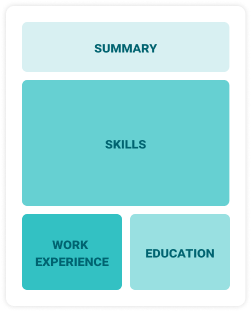
Best for:
Recent graduates and career changers with little to no experience
Combination
Balances skills and work history equally
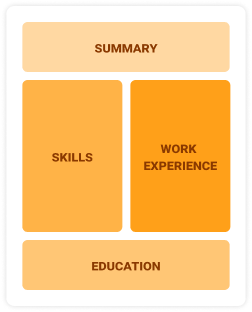
Best for:
Mid-career professionals eager to highlight their skills and growth potential
Chronological
Emphasizes work history in reverse order
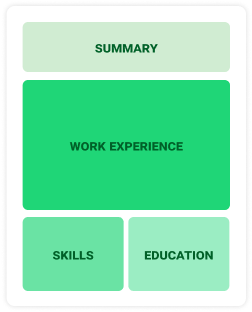
Best for:
Seasoned machinists excelling in precision engineering and team leadership
Machinist Salaries in the Highest-Paid States
Our machinist salary data is based on figures from the U.S. Bureau of Labor Statistics (BLS), the authoritative source for employment trends and wage information nationwide.
Whether you're entering the workforce or considering a move to a new city or state, this data can help you gauge what fair compensation looks like for machinists in your desired area.
Frequently Asked Questions
Should I include a cover letter with my machinist resume?
Absolutely. Including a cover letter can give you an edge by showcasing your unique skills and enthusiasm for the position. It allows you to connect your experience directly to the job requirements. For tips on crafting a compelling cover letter, explore our comprehensive guide on how to write a cover letter or use our Cover Letter Generator for quick assistance.
Can I use a resume if I’m applying internationally, or do I need a CV?
When applying for jobs outside the U.S., especially in Europe and Asia, use a CV instead of a resume. A CV provides a comprehensive overview of your qualifications. Explore our resources on how to write a CV and check out various CV examples to ensure your application meets international standards.
What soft skills are important for machinists?
For a machinist, attention to detail, problem-solving, and interpersonal skills are key soft skills. These abilities ensure precision in operations and foster a collaborative environment that improves productivity and safety in the workplace.
I’m transitioning from another field. How should I highlight my experience?
Highlight your transferable skills such as attention to detail, teamwork, and analytical thinking when applying for machinist roles. These abilities demonstrate your potential to excel, even if you lack direct experience in machining. Use concrete examples from your previous jobs to illustrate how you've successfully tackled challenges similar to those faced in a machining environment.
Where can I find inspiration for writing my cover letter as a machinist?
For machinists looking to improve their job applications, exploring professional cover letter examples can be invaluable. These samples offer inspiration for structuring your own letters, presenting your skills effectively, and showcasing your qualifications in a compelling way. Don’t miss out on the guidance these resources provide.
How should I format a cover letter for a machinist job?
When you format a cover letter for machinist positions, start with your contact details at the top. Follow this by including a formal greeting and an engaging introduction that showcases your interest in the role. Make sure to clearly outline your relevant skills and experiences, aligning them with the job requirements. Conclude with a strong closing statement that invites further discussion and demonstrates enthusiasm for the opportunity.


